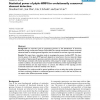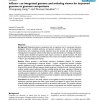JCB
2008
14 years 12 days ago
2008
The spatial clustering of genes across different genomes has been used to study important problems in comparative genomics, from identification of operons to detection of homologo...
BMCBI
2007
14 years 13 days ago
2007
Background: Thermophilic organisms are able to live at high temperatures ranging from 50 to > 100°C. Their proteins must be sufficiently stable to function under these extreme...
BMCBI
2007
14 years 13 days ago
2007
Background: As the number of fully sequenced genome increases, the need is greater for bioinformatics to predict or annotate genes of a newly sequenced genome. Ever since Eisenber...
BMCBI
2007
14 years 13 days ago
2007
Background: Despite a remarkable success in the computational prediction of genes in Bacteria and Archaea, a lack of comprehensive understanding of prokaryotic gene structures pre...
BMCBI
2007
14 years 13 days ago
2007
Background: A widely-used approach for discovering functional and physical interactions among proteins involves phylogenetic profile comparisons (PPCs). Here, proteins with simila...
BMCBI
2007
14 years 13 days ago
2007
Background: An important goal of comparative genomics is the identification of functional elements through conservation analysis. Phylo-HMM was recently introduced to detect conse...
BMCBI
2006
14 years 14 days ago
2006
Background: Systematic genome comparisons are an important tool to reveal gene functions, pathogenic features, metabolic pathways and genome evolution in the era of post-genomics....
BMCBI
2006
14 years 14 days ago
2006
Background: The rapidly increasing speed with which genome sequence data can be generated will be accompanied by an exponential increase in the number of sequenced eukaryotes. Wit...
BMCBI
2006
14 years 14 days ago
2006
Background: In Eukaryotic genomes, different features including genes are not uniformly distributed. The integration of annotation information and genomic position of functional D...
BMCBI
2006
14 years 14 days ago
2006
Background: Automated comparison of complete sets of genes encoded in two genomes can provide insight on the genetic basis of differences in biological traits between species. Gen...





